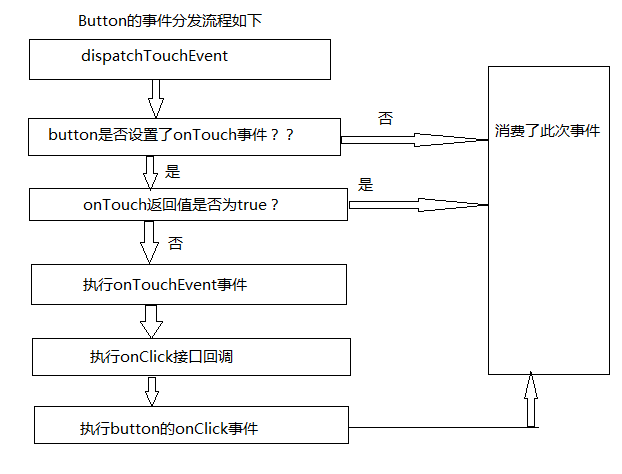关于Android View 事件分发过程的文章网络上可以搜到一把大,这里贴一篇代码性的文章,作者也是个牛人:Android事件分发机制完全解析,带你从源码的角度彻底理解(上)。
虽然讲的很好,但是看完之后还是感觉有那么点一知半解,于是自己花了点时间从源码研究android 触摸事件分发流程,以下内容仅仅个人理解,如有差错希望指出。
我们先从一个例子看起,先重写一个MyButton 继承Button,代码如下:
public class MyButton extends Button { public MyButton(Context context) { super(context); } public MyButton(Context context, AttributeSet attrs) { super(context, attrs); } public MyButton(Context context, AttributeSet attrs, int defStyleAttr) { super(context, attrs, defStyleAttr); } @Override public boolean dispatchTouchEvent(MotionEvent event) { switch (event.getAction()) { case MotionEvent.ACTION_DOWN: MyLog.e("dispatchTouchEvent====MyButton=====ACTION_DOWN"); break; case MotionEvent.ACTION_MOVE: MyLog.e("dispatchTouchEvent====MyButton=====ACTION_MOVE"); break; case MotionEvent.ACTION_UP: MyLog.e("dispatchTouchEvent====MyButton=====ACTION_UP"); break; } return super.dispatchTouchEvent(event); } @Override public boolean onTouchEvent(MotionEvent event) { switch (event.getAction()) { case MotionEvent.ACTION_DOWN: MyLog.e("onTouchEvent====MyButton=====ACTION_DOWN"); break; case MotionEvent.ACTION_MOVE: MyLog.e("onTouchEvent====MyButton=====ACTION_MOVE"); break; case MotionEvent.ACTION_UP: MyLog.e("onTouchEvent====MyButton=====ACTION_UP"); break; } return super.onTouchEvent(event); }<RelativeLayout xmlns:android="http://schemas.android.com/apk/res/android" xmlns:tools="http://schemas.android.com/tools" android:layout_width="match_parent" android:layout_height="match_parent" android:paddingBottom="@dimen/activity_vertical_margin" android:paddingLeft="@dimen/activity_horizontal_margin" android:paddingRight="@dimen/activity_horizontal_margin" android:paddingTop="@dimen/activity_vertical_margin" tools:context=".MainActivity"> <com.xjp.testtouchevent.MyButton android:id="@+id/myButton" android:layout_width="wrap_content" android:layout_height="wrap_content" android:text="测试" /></RelativeLayout>
测试Activity如下:
public class MainActivity extends ActionBarActivity { private Button myButton; @Override protected void onCreate(Bundle savedInstanceState) { super.onCreate(savedInstanceState); setContentView(R.layout.activity_main); myButton = (Button) findViewById(R.id.myButton); myButton.setOnTouchListener(new View.OnTouchListener() { @Override public boolean onTouch(View v, MotionEvent event) { switch (event.getAction()) { case MotionEvent.ACTION_DOWN: MyLog.e("onTouch====MyButton=====ACTION_DOWN"); break; case MotionEvent.ACTION_MOVE: MyLog.e("onTouch====MyButton=====ACTION_MOVE"); break; case MotionEvent.ACTION_UP: MyLog.e("onTouch====MyButton=====ACTION_UP"); break; } return false; } }); myButton.setOnClickListener(new View.OnClickListener() { @Override public void onClick(View v) { MyLog.e("onClick====MyButton=====onClick"); } }); }}
点击测试按钮,打印结果如下:

我们从打印结果可以直观看到,点击Button按钮事件分发过程如下 dispatchTouchEvent---->onTouch---->onTouchEvent----->onClick。并且如果仔细的你会发现,都是在ACTION_UP事件之后才触发onClick点击事件,为什么会是这样??现在我们不得而知。我们仅仅是从打印结果推测事件分发的结论,现在我们从源码分析下这个事件分发流程为什么是这样子。
事件分发都是从dispatchTouchEvent方法开始的,那么我们这里是重写了dispatchTouchEvent方法,并且最后也调用了父类的super.dispatchTouchEvent(event)方法。那么我们看看父类中的方法到底做了什么??点击进入父类的dispatchTouchEvent方法,发现此方法在View类中找到,其实也不奇怪,所有控件的父类都是View。这里我贴出最新源码如下:
public boolean dispatchTouchEvent(MotionEvent event) { boolean result = false; if (mInputEventConsistencyVerifier != null) { mInputEventConsistencyVerifier.onTouchEvent(event, 0); } final int actionMasked = event.getActionMasked(); if (actionMasked == MotionEvent.ACTION_DOWN) { // Defensive cleanup for new gesture stopNestedScroll(); } if (onFilterTouchEventForSecurity(event)) { //noinspection SimplifiableIfStatement ListenerInfo li = mListenerInfo; if (li != null && li.mOnTouchListener != null && (mViewFlags & ENABLED_MASK) == ENABLED && li.mOnTouchListener.onTouch(this, event)) { result = true; } if (!result && onTouchEvent(event)) { result = true; } } if (!result && mInputEventConsistencyVerifier != null) { mInputEventConsistencyVerifier.onUnhandledEvent(event, 0); } // Clean up after nested scrolls if this is the end of a gesture; // also cancel it if we tried an ACTION_DOWN but we didn't want the rest // of the gesture. if (actionMasked == MotionEvent.ACTION_UP || actionMasked == MotionEvent.ACTION_CANCEL || (actionMasked == MotionEvent.ACTION_DOWN && !result)) { stopNestedScroll(); } return result; }忽略其他无关代码,我们直接看17--25行。第17行的if判断关键在于li.mOnTouchListener.onTouch(this, event) 的返回值,这个接口回调就是我们外面写的myButton.setOnTouchListener事件(Button 的onTouch事件),在MainActivity代码里,我们setOnTouchListener返回的值是false,所以在源码中我们可以看到 17行的条件不成立,那么条件不成立,result=false;因此,源码的第23行if 判断第一个条件成立,继续执行第二个条件,也就是onTouchEvent。我们跳到这个方法里看看里面干啥了?看如下代码:
public boolean onTouchEvent(MotionEvent event) { if (((viewFlags & CLICKABLE) == CLICKABLE || (viewFlags & LONG_CLICKABLE) == LONG_CLICKABLE)) { switch (event.getAction()) { case MotionEvent.ACTION_UP: boolean prepressed = (mPrivateFlags & PFLAG_PREPRESSED) != 0; if ((mPrivateFlags & PFLAG_PRESSED) != 0 || prepressed) { // take focus if we don't have it already and we should in // touch mode. boolean focusTaken = false; if (isFocusable() && isFocusableInTouchMode() && !isFocused()) { focusTaken = requestFocus(); } if (prepressed) { // The button is being released before we actually // showed it as pressed. Make it show the pressed // state now (before scheduling the click) to ensure // the user sees it. setPressed(true, x, y); } if (!mHasPerformedLongPress) { // This is a tap, so remove the longpress check removeLongPressCallback(); // Only perform take click actions if we were in the pressed state if (!focusTaken) { // Use a Runnable and post this rather than calling // performClick directly. This lets other visual state // of the view update before click actions start. if (mPerformClick == null) { mPerformClick = new PerformClick(); } if (!post(mPerformClick)) { performClick(); } } } if (mUnsetPressedState == null) { mUnsetPressedState = new UnsetPressedState(); } if (prepressed) { postDelayed(mUnsetPressedState, ViewConfiguration.getPressedStateDuration()); } else if (!post(mUnsetPressedState)) { // If the post failed, unpress right now mUnsetPressedState.run(); } removeTapCallback(); } break; return true; } return false; }我们看看这里边都做了些什么,忽略其他,我们直接看37行的 performClick(); 方法,跳进去继续看,(注意:这里的performClick方法是在ACTION_UP手势里边执行的哦!!!)
public boolean performClick() { final boolean result; final ListenerInfo li = mListenerInfo; if (li != null && li.mOnClickListener != null) { playSoundEffect(SoundEffectConstants.CLICK); li.mOnClickListener.onClick(this); result = true; } else { result = false; } sendAccessibilityEvent(AccessibilityEvent.TYPE_VIEW_CLICKED); return result; }看见没??第6行 li.mOnClickListener.onClick(this); 这个接口回调就是我们Button的 onClick事件。到此为止,我们从源码分析了Button事件分发过程结论:dispatchTouchEvent---->onTouch---->onTouchEvent----->onClick。并且如果仔细的你会发现,是在所有ACTION_UP事件之后才触发onClick点击事件。
现在我们来看看其他情况:当onTouch返回为true,打印结果如下:

惊奇的发现,竟然没有执行onClick事件是吧????如果你仔细阅读上面的文章,估计你知道为什么了吧?还是跟大家一起分析一下吧:源码如下:
public boolean dispatchTouchEvent(MotionEvent event) { boolean result = false; if (mInputEventConsistencyVerifier != null) { mInputEventConsistencyVerifier.onTouchEvent(event, 0); } final int actionMasked = event.getActionMasked(); if (actionMasked == MotionEvent.ACTION_DOWN) { // Defensive cleanup for new gesture stopNestedScroll(); } if (onFilterTouchEventForSecurity(event)) { //noinspection SimplifiableIfStatement ListenerInfo li = mListenerInfo; if (li != null && li.mOnTouchListener != null && (mViewFlags & ENABLED_MASK) == ENABLED && li.mOnTouchListener.onTouch(this, event)) { result = true; } if (!result && onTouchEvent(event)) { result = true; } } if (!result && mInputEventConsistencyVerifier != null) { mInputEventConsistencyVerifier.onUnhandledEvent(event, 0); } // Clean up after nested scrolls if this is the end of a gesture; // also cancel it if we tried an ACTION_DOWN but we didn't want the rest // of the gesture. if (actionMasked == MotionEvent.ACTION_UP || actionMasked == MotionEvent.ACTION_CANCEL || (actionMasked == MotionEvent.ACTION_DOWN && !result)) { stopNestedScroll(); } return result; }从第17行可以看出,条件成立,result=true;那么第23行if条件根本不会执行第二个判断,那么就不会执行onTouchEvent方法,也就不会调用 onClick的接口,因此Button 不会执行setOnClickListener中的onClick事件。
给个简单的流程图如下

因此,事件分发之间的关系是:dispatchTouchEvent方法中线执行 onTouch接口回调,然后根据onTouch方法的返回值判断是否执行onTouchEvent方法,onTouchEvent方法中执行了onClick接口回调。